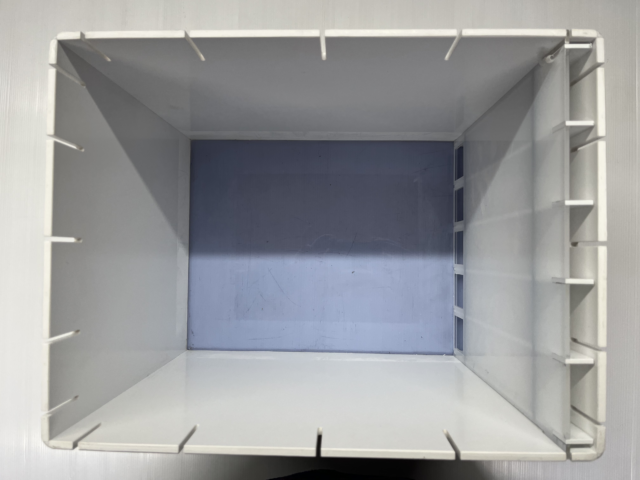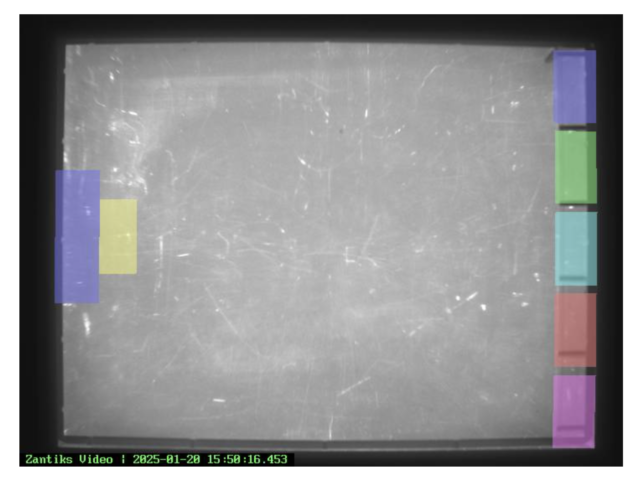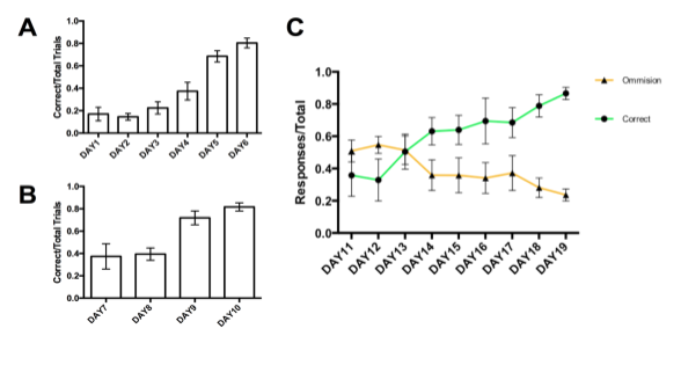This is a continuous performance test used to assess attentional processes and impulse control.
During this task, an animal is required to respond to the presence of a briefly presented stimulus (typically a light) in one of 5 locations at the rear of the testing chamber. Aspects of attention and executive performance can be investigated through manipulation of stimulus light exposure length and the addition of distractors. Impulsivity can be measured through the animals’ premature or anticipatory responding (i.e., responding prior to the stimulus light onset).
Experimental setup for adult zebrafish
The Zantiks AD and LT units can be used for the 5-CSRTT in adult zebrafish. The five aperture (5-choice) insert is used to separate the 5 markers (i.e. target zones) that the fish can choose from during the trial. The 5-choice insert slots into the tank at the opposite end to the feeder tube. When facing the LT this will be on the right, while on the AD, the insert would be at the back as the feeder tube is at the front. The space under the feeder tube is marked by the asset as the area for fish to collect a food reward. There is also a smaller target zone marked out near the feeder tube which will light up on the base screen as the point for initiating trials. The 5-choice insert creates five entry points at the opposite end of the tank from food delivery. The five holes act in a similar fashion to the five nose poke holes in a rodent version of the task.
White light is typically used as stimuli for this experiment, which is presented from the integrated screen below the testing tank. Target zones are assigned to specific locations within the tank (e.g., the five stimulus light locations. Responses are detected when a fish enters these zones.
The images below show the 5-Choice serial reaction time task insert in the Zantiks LT tank, and the asset drawing of the 5 apertures, the target zone to initiate the trial and the feeding area:


Video recorded during the running of the experiment. A fish is tracked, as indicated by the white cross. Stimuli are not visible on the live tracking image due to the infra-red tracking, so the stimuli are denoted on the image with coloured boxes.
Experimental procedure
5-CSRTT training is divided into five distinct training stages. All sessions are typically run for 30 minutes or 30 trials, whichever comes first.
- Habituation (stage 1): All lights are illuminated (initiator and 5 stimulus lights) for 50 sec. Entry into any illuminated area is reinforced with a small food reward. This is followed by a 10 sec intertrial interval (ITI) during which no lights are illuminated. A ‘correct’ response is recorded as the zebrafish swimming into the area when illuminated and returning to the feed delivery area. A fish moved to the next stage of training when it completes ≥ 50% trials correctly.
- Initiator training (stage 2): Only the initiator light is illuminated for 50 sec (10 sec ITI). A ‘correct’ response is recorded as the zebrafish swimming into the initiator area when illuminated. The correct response is reinforced with a food reward. A fish moved to the next stage of training when it completes ≥ 50% trials correctly in two sessions consecutively.
- Stimulus light training (stage 3): Fish are required to swim into the initiator light to start the trial. In a trial, all five of the stimulus lights are illuminated immediately for 50 sec (10 sec ITI). If the fish swims into any of the stimulus light areas, it is reinforced with food reward. A fish moved to the next stage of training when it completes ≥ 50% trials correctly in two sessions consecutively.
- 5-CSRTT/No-Delay (stage 4): Fish are required to swim into the initiator light to start the trial. In a trial, one of the five of the stimulus lights is illuminated immediately for 50 sec (10 sec ITI). If the fish swims into the illuminated area it is reinforced with food reward. In this stage, the requirement for correct responses changes. A correct response is the total correct responses as a function of total trials in which the fish made a choice (i.e., accuracy= TotalCORRECT / (TotalCORRECT + TotalINCORRECT)). A fish moved to the final stage of training when it completes ≥ 80% trials correctly in two sessions consecutively. They also must complete a minimum of 10 of the 30 total trials in a session during each of the two ≥ 80% correct sessions.
- 5-CSRTT/Delay and drug treatment (stage 5): Fish are required to swim into the initiator light to start the trial. In a trial, one of the five of the stimulus lights is illuminated immediately for 50 sec (10 sec ITI) following a variable interval (VI) delay of mean = 10 sec. If the fish swims into the illuminated stimulus light, it is reinforced with food reward. As testing is now for impulsivity, as well as correct responses, premature responses are recorded (i.e., anticipatory responding= TotalPREMATURE / (TotalPREMATURE + TotalCORRECT + TotalINCORRECT)).
Results/data output
There are several parameters that are commonly used in the 5-choice serial reaction time tasks including: correct responses (responses to correct stimulus light) and incorrect responses (responses to the incorrect location), omissions (not responding following stimulus presentation) and premature responses (responding to any of the apertures prior to stimulus presentation). Zantiks units can be scripted to automatically process these variables.
- Accuracy: CORRECT/(CORRECT + INCORRECT)*100 – a measure of selective attention
- Percent Correct: CORRECT / (TOTAL NUMBER OF TRIALS)*100 – a measure of overall performance
- Percent Omission: OMISSIONS / (OMISSIONS + CORRECT + INCORRECT)*100 – a measure of sustained attention/motivation
- Anticipatory responses: EARLY/(EARLY + CORRECT + INCORRECT)*100 – a measure of impulsivity/response inhibition
The number of sessions needed to reach criterion for a stage of training in the 5-CSRTT can be analysed by repeated measures ANOVA (GLM-RM) with group (e.g., drug dose, genotype) (between) and session (within) factors.

Protocol scripts downloads
There are five separate scripts for the 5-Choice Serial Reaction Time Task for adult zebrafish. The initial four scripts will shape the subject's behaviour to the needed response and the final script introduces a random delay between initiation of the trial and the stimulus light appearing.
There is one asset you will need which creates the initiator, feeder and stimulus light areas.
- 5CSRTT_all_detectors_training.zs
- Initiator light and all 5 stimulus lights are presented together. Any light entered will result in food reward.
- 5CSRTT_initiator_light_training.zs
- Only the initiator light is presented now and needs to be entered in order food reward to be given.
- 5CSRTT_ini_stimulus_training.zs
- Initiator light needs to be entered in order for all 5 stimulus lights to be presented. Food reward can be obtained by entering any of the 5 stimulus locations.
- 5CSRTT_discrimination_training.zs
- Initiator light needs to be entered in order for one light to be presented in one of the 5 stimulus locations and the animal needs to enter the lit location to obtain food.
-
5CSRTT_random_delay.zs
- A random delay is introduced before stimulus presentation of 1, 2, 4, 8, or 12 secs.
Asset
You will need to upload the appropriate asset into the Asset directory on your Zantiks Control Console and ensure the correct asset name is in the LOAD(ZONES,"name_of_asset") command in the script.
See the Calibrating your Zantiks unit page and Asset building in the AD unit page or Asset building in the LT unit page for details on how to create assets customised to your system.
NOTE: The typical asset used for the 5 choice serial reaction time task is a "zone asset" with 5 aperture areas for tracking responses and a feeding/reward area.



